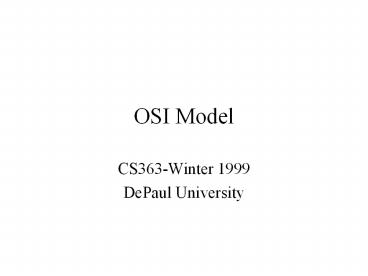OSI%20Model - PowerPoint PPT Presentation
Title:
OSI%20Model
Description:
OSI Model CS363-Winter 1999 DePaul University – PowerPoint PPT presentation
Number of Views:129
Avg rating:3.0/5.0
Title: OSI%20Model
1
OSI Model
- CS363-Winter 1999
- DePaul University
2
Group Project Info
- Teams formed and on the web
- Cases
- Working in Groups
- Last half of class tonight reserved for projects
3
Review 1
- You must connect a research institutions main
offices with the testing site 30 miles away. You
will connect them with fiber optic cable. Which
type of fiber will you use and why?
4
Review 2
- You are replacing your thicknet backbone between
your servers with a high-speed network cable. You
are considering using Category 5 twisted-pair
copper or multimode fiber cable. - Under what circumstances will you install the
fiber? - Under what circumstances will you not use fiber?
5
Review 3
- Your company recently renovated its telephone
system, including cabling, and had extra cable
installed for future growth. Now you would like
to use the excess cabling to network the
computers in your company. - What sort of network performance (data capacity
and cable length) can you reasonable expect from
these new telephone cables? - What could you do with the old telephone cable
that is still in the building?
6
Review 4
- You would like to attach your notebook computer
to your LAN, but it does not have a PCMCIA slot
or a place for a proprietary network card. How
can you attach it to the network?
7
OSI Model
- Why do we keep talking about this? Why should we
care?
8
Protocol Stacks
- gtgroup of protocols arranged on top of each
other as part of a communications process. - Importance of protocol stacks
9
Peer-Layer Communication Between Stacks
10
Physical Layer
- Functions
- Components
11
Data-Link Layer
- Functions
- Components
12
Network Layer
- Functions
- Components routers and gateways
13
Transport Layer
- Functions
- Components
14
Session Layer
- Functions
- Components
15
Presentation Layer
- Functions
- Components
16
Application Layer
- Functions
- Components
17
Problem
- Your company wants to use data link layer
encryption devices to send private data over a
public wide area network. What effect will this
have on devices in other layers?
18
Problem
- When trouble-shooting your network with a packet
sniffer, you find a device generating spurious
TCP/IP packets. Which devices are suspect?
19
Drivers
- gt
- NDIS
- ODI
20
Network Protocols
- gtagreed-upon ways in which computers exchange
information
21
How Protocols Work
- Sending
- Packetize data
- Appropriately address the packets
- Present packets to the network for delivery
- Receiving
- -Accept packets from the network
- Remove transmitting information (addresses) added
in the sending process - Reassemble data packets into original message
22
Network Packets
- Packet Structure
- Headergt
- Datagt
- Trailergt
23
Packet Assembly
- Routing
- Protocol Stacks
24
Binding Protocols
25
Two Types of Protocols
- Connection-Oriented
- Connectionless
26
Standard Protocol Stacks
- ISO/OSI
- SNA
- DECnet
- NetWare
- AppleTalk
- TCP/IP
27
Microsoft Supported Transport Protocols
- NetBEUI
- NWLink
- TCP/IP
28
Other Protocols whose names you should know
- SMTP
- SNMP
- NFS
- X.25
- X Windows
29
Problem
- Your boss wants you to speed up the office LAN
without spending any money. You are currently
using 10Mbps Ethernet and TCP/IP. Users connect
to the Internet using dial-up modems, and a
single Ethernet domain is in use. What do you
do?
30
Problem
- Your company network has become very slow, so you
decide to break it up into multiple domains and
use a router to connect the domains. As soon as
you disconnect the networks, even with the router
running properly, you cant get data between
networks. You are using four Windows NT servers
(one in each subnetwork) running on Ethernet with
NetBEUI. Youve spent your budget on the router
and cant afford to purchase new hardware. What
is wrong? How can you fix it?































